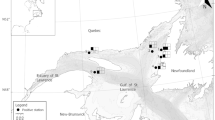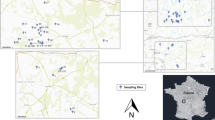Abstract
The pond smelt Hypomesus nipponensis and Japanese icefish Salangichthys microdon are economically important fishery resources in Japan. The catching of these fish species has decreased owing to environmental pollution and habitat loss caused by human impacts. We developed species-specific primer–probe sets to detect and quantify environmental DNA (eDNA) in these fish species. The primer–probe sets were specific to each target species with the detection limits of two (H. nipponensis) and one (S. microdon) copies per reaction, sufficient for eDNA analysis in the field. Using these assays, the eDNA was detected with a high probability (100% and 86% for H. nipponensis and S. microdon, respectively) at the sites where each fish species was captured by a cast net survey in the Hirata–Funagawa River (one of the inflowing rivers of Lake Shinji, Shimane Prefecture, Japan), where it was frequently detected without cast net capture. The eDNA was detected in S. microdon a little earlier than in H. nipponensis, and the eDNA concentrations of both species gradually decreased after peaking in July and reached negligible levels by October. The utility of the assays for estimating the seasonal appearances/disappearances of both species in this river was demonstrated. The species-specific primer–probe sets of the eDNA-based method represent a potentially useful monitoring tool that requires minimal labor and time and could be useful for managing H. nipponensis and S. microdon fisheries in the future.



Similar content being viewed by others
References
Barnes MA, Turner CR (2016) The ecology of environmental DNA and implications for conservation genetics. Conserv Genet 17:1–17
Evans NT, Lamberti GA (2018) Freshwater fisheries assessment using environmental DNA: a primer on the method, its potential, and shortcomings as a conservation tool. Fish Res 197:60–66
Fujikawa Y, Imai C (2016) Estimation of spawning population of pond smelt Hypomesus nipponensis by the egg production method in Lakes Shinji and Nakaumi, Japan. Bull Jpn Soc Fish Oceanogr 80:124–128
Fujikawa Y, Katayama S (2014) Spawning grounds and season of pond smelt Hypomesus nipponensis in Lakes Shinji and Nakaumi, Japan. Aquacult Sci 62:375–384 (in Japanese with English summary)
Fujikawa Y, Moriyama M, Okita S (2003) Ecology survey of important aquatic animals (pond smelt, Hypomesus nipponensis, and Japanese icefish, Salangichthys microdon). Rep Shimane Prefect Fish Technol Cent 4:95–111 (in Japanese)
Hayashi M, Sasaki K, Nakano H, Teraoka S, Yamaguchi K, Koshikawa T (2008) Records on invertebrate and vertebrate of rivers and streams in Hirata area, Izumo City, Shimane Prefecture. Jpn Bull Hoshizaki Green Found 11:1–60 (in Japanese)
Hosoya K (2000) Osmeridae. In: Nakabo T (ed) Fishes of Japan with pictorial keys to the species. Tokai University Press, Tokyo, pp 358–359 (in Japanese)
Ishida K, Fukui K (2019) Spawning, embryonic development, hatching, and vertical distribution of larvae, juveniles and adults of icefish Salangichthys microdon in Lake Shinji. Rep Shimane Prefect Fish Technol Center 12:5–9 (in Japanese)
Ishitobi Y, Hiratsuka J, Kuwabara H, Yamamuro M (2000a) Changes in fish and crustacean assemblage in connected coastal lagoons, Lake Nakaumi and Lake Shinji, Japan. Jpn J Limnol 61:129–146 (in Japanese with English summary)
Ishitobi Y, Hiratsuka J, Kuwabara H, Yamamuro M (2000b) Comparison of fish fauna in three areas of adjacent eutrophic estuarine lagoons with different salinities. J Mar Syst 26:171–181
Ishitobi Y, Hiratsuka J, Kuwabara H (2011) Subject of the comprehensive investigation and others for the promotion of the fisheries in Lakes Shinji and Nakaumi. Rep Shimane Prefect Fish Technol Cent 3:99–110 (in Japanese)
Jerde CL (2021) Can we manage fisheries with the inherent uncertainty from eDNA? J Fish Biol 98:341–353
Katano O, Hakoyama H, Matsuzaki SS (2015) Japanese inland fisheries and aquaculture: status and trends. In: Craig JF (ed) Freshwater fisheries ecology. Wiley, Chichester, pp 231–240
Kawashima T (1989) Population fluctuations of pond smelt (Hypomesus nipponensis) and icefish (Salangichthys microdon) in Lake Shinji. Rep Shimane Prefect Fish Technol Center 6:69–80 (in Japanese)
Lotze HK, Milewski I (2004) Two centuries of multiple human impacts and successive changes in a north Atlantic food web. Ecol Appl 14:1428–1447
Lotze HK, Coll M, Dunne JA (2011) Historical changes in marine resources, food-web structure and ecosystem functioning in the Adriatic Sea, Mediterranean. Ecosystems 14:198–222
Matsuzaki SS, Kadoya T (2015) Trends and stability of inland fishery resources in Japanese lakes: introduction of exotic piscivores as a driver. Ecol Appl 25:1420–1432
Myers RA, Worm B (2003) Rapid worldwide depletion of predatory fish communities. Nature 423:280–283
Nakamura M (2000) Fishery of Corbicula japonica in Japan. Tatara-Shobou, Shimane
Ochiai A, Tanaka M (1986) Salangichthys microdon BLEEKER, Hypomesus transpacificus nipponensis McALLISTER. In: Ochiai et al (eds) Ichthyology. Kouseisha-Kouseikaku, Tokyo, pp 475–483 (in Japanese)
Rodriguez-Ezpeleta N, Morissette O, Bean CW, Manu S, Banerjee P, Lacoursiere-Roussel A, Beng KC, Alter SE, Roger F, Holman LE, Stewart KA, Monaghan MT, Mauvisseau Q, Mirimin L, Wangensteen OS, Antognazza CM, Helyar SJ, de Boer H, Monchamp ME, Nijland R, Abbott CL, Doi H, Barnes MA, Leray M, Hablutzel PI, Deiner K (2021) Trade-offs between reducing complex terminology and producing accurate interpretations from environmental DNA: comment on “Environmental DNA: what’s behind the term?” by Pawlowski et al. (2020). Mol Ecol 30:4601–4605
Sakata MK, Maki N, Sugiyama H, Minamoto T (2017) Identifying a breeding habitat of a critically endangered fish, Acheilognathus typus, in a natural river in Japan. Naturwissenschaften 104:100
Sugiura K, Tomita S, Minamoto T, Mishina T, Iwata A, Abe T, Yamamoto S, Watanabe K (2021) Characterizing the spatial and temporal occurrence patterns of the endangered botiid loach Parabotia curtus by environmental DNA analysis using a newly developed species-specific primer set. Ichthyol Res 68:152–157
Takahara T, Minamoto T, Yamanaka H, Doi H, Kawabata Z (2012) Estimation of fish biomass using environmental DNA. PLoS ONE 7:e35868
Takahara T, Minamoto T, Doi H (2013) Using environmental DNA to estimate the distribution of an invasive fish species in ponds. PLoS ONE 8:e56584
Takahara T, Ikebuchi T, Doi H, Minamoto T (2019) Using environmental DNA to estimate the seasonal distribution and habitat preferences of a Japanese basket clam in Lake Shinji, Japan. Estuar Coast Shelf Sci 221:15–20
Takahara T, Taguchi J, Yamagishi S, Doi H, Ogata S, Yamanaka H, Minamoto T (2020) Suppression of eDNA degradation in water samples associated with different storage temperature and period using benzalkonium chloride. Limnol Oceanogr Methods 18:437–445
Tateishi A, Tsuji S, Yamanaka H, Inui R, Akamatsu Y, Takahara T (2020) Seasonal distribution of Japanese mitten crab (Eriocheir japonica) in Lake Shinji-Nakaumi based on environmental DNA. Laguna 27:87–100 (in Japanese with English summary)
Thomsen PF, Willerslev E (2015) Environmental DNA—an emerging tool in conservation for monitoring past and present biodiversity. Biol Conserv 183:4–18
Tsuji S, Takahara T, Doi H, Shibata N, Yamanaka H (2019) The detection of aquatic macroorganisms using environmental DNA analysis—a review of methods for collection, extraction, and detection. Environ DNA 1:99–108
Uchii K, Doi H, Minamoto T (2016) A novel environmental DNA approach to quantify the cryptic invasion of non-native genotypes. Mol Ecol Resour 16(2):415–422. https://doi.org/10.1111/1755-0998.12460
Wilcox TM, Mckelvey KS, Young MK, Jane SF, Lowe WH, Whiteley AR, Schwartz MK (2013) Robust detection of rare species using environmental DNA: the importance of primer specificity. PLoS ONE 8:e59520
Wu Q, Kawano K, Uehara Y, Okuda N, Hongo M, Tsuji S, Yamanaka H, Minamoto T (2018) Environmental DNA reveals non-migratory individuals of Palaemon paucidens overwintering in Lake Biwa shallow waters. Freshw Sci 37:307–314
Yamamuro M, Komuro T, Kamiya H, Kato T, Hasegawa H, Kameda Y (2019) Neonicotinoids disrupt aquatic food webs and decrease fishery yields. Science 366:620–623
Yamanaka H, Minamoto T (2016) The use of environmental DNA of fishes as an efficient method of determining habitat connectivity. Ecol Indic 62:147–153
Yamanaka H, Minamoto T, Matsuura J, Sakurai S, Tsuji S, Motozawa H, Hongo M, Sogo Y, Kakimi N, Teramura I, Sugita M, Baba M, Kondo A (2017) A simple method for preserving environmental DNA in water samples at ambient temperature by addition of cationic surfactant. Limnology 18:233–241
Yatsuyanagi T, Ishida R, Sakata MK, Kanbe T, Mizumoto H, Kobayashi Y, Kamada S, Namba S, Nii H, Minamoto T, Araki H (2020) Environmental DNA monitoring for short-term reproductive migration of endemic anadromous species, Shishamo smelt (Spirinchus lanceolatus). Environ DNA 2:130–139
Acknowledgements
Ms. Mikie Fujii supported our research through personal donations. This research was supported by the Environment Research and Technology Development Fund (JPMEERF20164002) of the Environmental Restoration and Conservation Agency, Japan and by JST CREST (JPMJCR13A2), Japan. Kousuke Ikeda, Yusuke Ochiai, and Atsuko Kato (Pacific Consultants Co., Ltd.) provided samples for our research. We thank the Department of Molecular and Functional Genomics, Interdisciplinary Center for Science Research, Organization for Research and Academic Information, Shimane University, for providing the DNA facilities. The authors thank the faculty of Life and Environmental Sciences at Shimane University for providing financial support for publishing this report.
Funding
Environmental Restoration and Conservation Agency, JPMEERF20164002, Teruhiko Takahara, Core Research for Evolutional Science and Technology, JPMJCR13A2, Toshifumi Minamoto.
Author information
Authors and Affiliations
Corresponding author
Ethics declarations
Conflict of interest
TM is an inventor of the patent for the use of BAC to eDNA preservation.
Supplementary Information
Below is the link to the electronic supplementary material.
Rights and permissions
About this article
Cite this article
Takahara, T., Fukui, K., Hiramatsu, D. et al. Development of primer–probe sets for environmental DNA-based monitoring of pond smelt Hypomesus nipponensis and Japanese icefish Salangichthys microdon. Landscape Ecol Eng 19, 11–19 (2023). https://doi.org/10.1007/s11355-022-00507-9
Received:
Revised:
Accepted:
Published:
Issue Date:
DOI: https://doi.org/10.1007/s11355-022-00507-9




